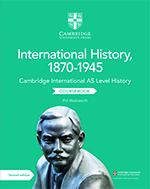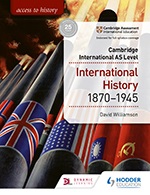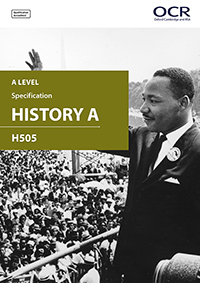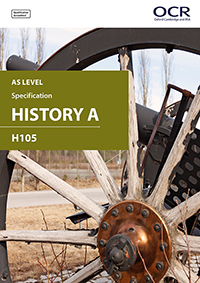

A Level History Coursework Edexcel – A Guide
- Post author By admin
- Post date November 16, 2023
- No Comments on A Level History Coursework Edexcel – A Guide
This guide shows you how to plan, research and write A Level History coursework for Edexcel using ideas, resources, examples and structure. This coursework is weighted towards Assessment Objective Three (AO3) 15% and Assessment Objective One (AO1) 5%. This makes it substantially different from coursework assessed under AQA or OCR. For Edexcel coursework, the focus is on differing interpretations of the past and analysis of them, alongside your own view of the events.
A Level History Coursework Edexcel – Ideas, Examples and Resources
Question Format – The question that you decide to answer for the Edexcel Coursework will always use the following template.
- Historians have disagreed about [ the chosen question, problem or issue ].
- What is your view about [ the chosen question, problem or issue ]?
Thus, we can see that there are two parts to this coursework:
- Part 1 – dealing with the historian’s viewpoints which is (AO3) and worth 15%
- Part 2 – your own viewpoint which is (A01) and worth 5%
Question Ideas, Example and Selection
There are two key points to consider when selecting a question, problem or issue for your coursework.
- Is there enough debate around this question? – There needs to be a scholarly debate around the question or issue. This means differing views on the question from different historians. This makes it easier to select appropriate works to analyse and compare.
- Can you access the appropriate resources? – You must use a minimum of three different key works as well as two supplementary works. Your three key works should hold opposing views about the question or issue. Let’s look at an example question to make this clear:
Historians have disagreed about the extent to which by 1924 the Russian people had exchanged one authoritarian regime for another. What is your view about the extent to which by 1924 the Russian people had exchanged one authoritarian regime for another?
- View 1 – Tsarist Rule was more authoritarian. (C. Hill argues this)
- View 2 – Bolshevik rule was more authoritarian. (R. Service argues this)
- View 3 – The regimes were equally authoritarian. (R. Pipes argues this)
This is the ideal example of having three viewpoints that would be spread across the historiographical spectrum. This helps us to engage with the historical debate and hit the following criteria for the coursework:
- analyse ways in which interpretations of the question or issue differ.
- explain the differences you have identified.
- evaluate the arguments, indicating which you found most persuasive and why.
You would then add to this a minimum of two supplementary works, (more is better) that would assist in helping you form your view and add weight to your analysis and arguments. Critically, you must be able to access all these resources to use them effectively in completing the coursework.
Coursework Resources
- Library – school, local, college, university – you should be able to borrow appropriate works.
- Teacher – your teacher should be able to provide you with copies of appropriate resources to use.
- JSTOR – www.jstor.org – contains a large collection of journal articles from historical publications covering numerous topics. These will often engage in the historical debate by replying to opposing views.
- Purchase Books – many second-hand books are available to purchase at very cheap prices through Amazon or similar sites.
A Level History Coursework Edexcel – How to Research and Write

Researching the Coursework – When researching our coursework we use the resource record form, which acts as a bibliography to the books, articles and online resources we are using. As we go through these resources we want to make notes that help us to identify the overall argument of the historian. Key quotes or passages should be noted down, alongside a reference. If we then use this material in our write up, we can add the appropriate footnote.
Writing the Coursework – When writing our coursework we need to be aware of the total word count as well as making sure that we hit all the assessment criteria. This means dividing up the 4000 words (maximum word count) effectively between the assessment criteria. An example structure to implement this is shown in the next section.

A Level History Coursework Edexcel – Structure and Planning
First section – introduction to the overall question and key works (c. 1000 words).
Introduction to the overall topic. You need to put the question into context by providing relevant information regarding what was happening at the time. You then need to define any key terms in the question.
Example from our question above – authoritarian regime would be defined as ‘a regime in which power is highly centralised and maintained regardless of popular support, with the use of repression and violence’.
Finally, you need to set out valid criteria by which the question can be judged.
Example from our question and definition above – we need to compare the Tsarist regime to the Bolshevik regime in terms of:
- Centralisation of power .
- Power maintained despite lacking popular support.
- Power maintained through repression and violence.
You should now have a complete introduction to the topic (1 paragraph)
Introduction to the debate by placing each of the key works in the historiographical debate. You can also place your supplementary works on the historiographical line here. (1 paragraph)
Set out the arguments in extended detail from the three key works. What are the historians’ views on this question? (1 paragraph)
Show how the arguments from each of the key works differ or are like one another. (1 paragraph)
Summary of the views of the key works. (1 paragraph)
Second Section – Explaining why the key works differ from one another (c. 1000 words)
Introduction – You need to set out three valid criteria to explain why the key works differ. Why is it that the historians’ arguments differ? There are several different potential criteria that could be used here: When was the work written? What sources and evidence did they use? Have they defined the key terms of the question differently? Have they defined the criteria to answer the question differently? Do they have different scopes of enquiry? What is the purpose of the work? What is the historians background and view?
Example from our question – The historians have defined the key term to answer the question differently – C. Hill has focused on authoritarian being defined as lacking popular support. R. Service is more focused on authoritarian being defined through repression. R. Pipes is mostly focused on authoritarian being defined as a centralisation of power.
The historians have defined the key term ‘authoritarian’ differently. (1 paragraph)
Paragraphs – This is where you use the criteria set out from the introduction to this section. You want one paragraph per item of criteria that we are judging the key works on.
Example from our question – one paragraph regarding how the historians have defined the key term ‘authoritarian’ differently.
Then you need to consider the three works in terms of the criteria set out for that paragraph. Show why there are differences in the key works regarding that criteria and how that leads the historian to arrive at their interpretation. Use evidence to support your points. (3 paragraphs – 1 for each criterion)
Conclusion – Brief conclusion that offers a summary of why the key works are different. (1 paragraph)
Third Section – Your own viewpoint on the question (c. 1000 words)
Brief introduction of your own viewpoint and line of argument that will be taken, remembering to re-instate the criteria by which the question can be judged . (1 paragraph)
Paragraphs that set out your own view on the question. This is where you should be using the criteria set out in your introductions. You want one paragraph per item of criteria.
Example from our question – one paragraph regarding ‘centralisation of power’.
Then you need to bring evidence and analysis to assess the criteria being judged. You can also use the key works and the supplementary works in this section to help you. (3 paragraphs – 1 for each criterion)
Conclusion that reaches a judgement on the question and follows your line of argument that has flowed throughout. (1 paragraph)
Fourth Section – Evaluation and Judgement of the key works and of the question (c. 1000 words)
Go through each of the key works and make a judgement on how convincing and valid the arguments from the historians are compared to the criteria. (3 paragraphs – 1 for each key work)
Form an overall judgement on the question and an overall judgement on which of the key works is most convincing. These should broadly align together. (1 paragraph)
How To Improve Further at A Level History
Pass A Level History – is our sister site, which shows you step by step, how to most effectively answer any A Level History extract, source or essay question. Please click the following link to visit the site and get access to your free preview lesson. www.passalevelhistory.co.uk
Previous and Next Blog Posts
Previous – A Level History Essay Structure – A Guide passhistoryexams.co.uk/a-level-history-essay-structure/
Next – A Level History Coursework AQA – A Guide passhistoryexams.co.uk/a-level-history-coursework-aqa/
Leave a Reply Cancel reply
You must be logged in to post a comment.
Programmes & Qualifications
Cambridge international as & a level history (9489).
- Syllabus overview
Cambridge International AS and A Level History is a flexible and wide-ranging syllabus covering modern history in the nineteenth and twentieth centuries. The syllabus builds upon skills gained at Cambridge IGCSE or Cambridge O Level and develops lifelong skills including understanding issues and themes within a historical period.
The emphasis is again on both historical knowledge and on the skills required for historical research. Learners develop an understanding of cause and effect, continuity and change, similarity and difference, and use historical evidence as part of their studies. Both at AS and A Level learners can select from topics on European, American or International history.
Teachers choose which periods to focus on, allowing them to build a course that reflects their learners' interests and staff specialisms, or which is relevant to the local or regional context.
The syllabus year refers to the year in which the examination will be taken.
- -->2021 - 2023 Syllabus update (PDF, 114KB)
- -->2021 Legacy Notice (PDF, 102KB)
- -->2024 - 2025 Syllabus (PDF, 774KB)
- -->2026 - 2027 Syllabus (PDF, 880KB)
Syllabus support
- -->Support for History (PDF, 1MB)
Syllabus updates
We have reviewed Cambridge International AS & A Level History as part of our rolling review programme to make sure it reflects the latest trends in this subject and developments in education. We have made some changes to meet the needs of students, teachers and higher education institutions around the world. The following changes are for assessment in 2021, 2022 and 2023.

How has the syllabus changed?
- We have refreshed the content and reviewed the amount of optionality within question papers to make sure candidates continue to benefit from having a range of options to choose from.
- cause & consequence
- change & continuity
- similarity & difference
- significance
- interpretations.
- We have added a list of command words and their meanings to help learners know what’s expected of them in the exam.
- The syllabus code will change to 9489.
How has the assessment changed?
- Papers 1 and 2 will share the same content and learners will continue to study one of three options: European, American or International.
- Each option will consist of 4 topics, which will rotate year-on-year. The topic which is the focus of Paper 1 in June and November of any given year is not used to set the questions for Paper 2. There will be a table in the syllabus clarifying when each topic will be used for which papers.
- Paper 3 Topic 1 The Causes and Impact of British Imperialism will be replaced by The Origins of the First World War.
- Paper 4: Depth study 4: African History, 1945–91, and Depth study 5: Southeast Asian History, 1945–90s (available in November only) have been removed.
When do these changes take place?
The updated syllabus is for examination in June and November 2021, 2022 and 2023. Please see the 2021-2023 syllabus above for full details.
Coming soon
We are developing a wide range of support to help you plan and teach the 2021-2023 syllabus.
Look out for a range of support including a Scheme of work, Example candidate responses, Teacher and Learner guides. These materials will be available before first teaching from April 2019 onwards through our School Support Hub .
Endorsed resources

Increased depth of coverage and closely mapped to the new Cambridge syllabus, this series provides a wide range of source material and language support. Builds confidence in the skills of language, essay writing and evaluation.
Read more on the Cambridge University Press website

Develop knowledge and analytical skills with engaging and comprehensive coverage of the Cambridge International AS Level History syllabuses for examination from 2021.
Read more on the Hodder website
Important notices
We are withdrawing Cambridge International AS & A Level History (9489) from the March exam series. The last March series for this syllabus will be March 2025.
From 2026, we will only offer this syllabus in the June and November exam series.
We communicated this change to schools in September 2022.
For some subjects, we publish grade descriptions to help understand the level of performance candidates’ grades represent.
We paused the publication of grade descriptions in response to the Covid-19 pandemic and the temporary changes to the awarding standard in 2020, 2021 and 2022.
As the awarding standard has now returned to the pre-pandemic standard, we are working to produce up-to-date grade descriptions for most of our general qualifications. These will be based on the awarding standards in place from June 2023 onwards.
School Support Hub
Teachers at registered Cambridge schools can unlock over 30 000 teaching and learning resources to help plan and deliver Cambridge programmes and qualifications, including Schemes of work, Example candidate responses, Past papers, Specimen paper answers, as well as digital and multimedia resources.
Schemes of work
Example responses, past papers, specimen paper answers.
Register your interest in becoming a Cambridge School
Stay up to date
Sign up for updates about changes to the syllabuses you teach
- Past papers, examiner reports and specimen papers
- Published resources
- Centre Services
- Associate Extranet
- All About Maths
Request blocked
This request has been blocked as part of the aqa security policy.
Your support ID is: 14772493162076166353
If you're seeing this message in error, call us on 0800 197 7162 (or +44 161 696 5995 outside the UK) quoting the support ID above.
Return to previous page
OCR homepage
Administration
- Active Results
- Interchange
- Submit for Assessment
- Teach Cambridge
- ExamBuilder
- Online Support Centre
Main navigation
As and a level history a - h105, h505.
If you are delivering this qualification, go to Teach Cambridge for complete planning, teaching and assessment support materials.

Our A Level in History A allows students to select from over 50 topics of British and non-British history, going beyond the most commonly taught areas. They will develop critical and reflective thinking, which they demonstrate in an essay exploring a topic of their own choosing.
Specification code: H505 Qualification number: 601/4701/5 This qualification is available in English only

Our AS Level in History A engages students’ interest in history, developing their understanding of the nature of historical study, and the evidence on which historical judgements are based. Students select two topics covering both British and non-British history.
Specification code: H105 Qualification number: 601/4843/3 This qualification is available in English only
Resource materials
Information, getting started, case studies and support
Example planning guides, teaching activities and more.
Practice papers, example answers, past papers and mark schemes
Upcoming professional development
Choosing ocr: a level history h505 (webinar).
CPD course • Online webinar • FREE • AS and A Level History A - H105, H505
Date: 03 Jul 2024 3:30pm-4:30pm
Ask the Subject Advisor: A Level History H505 (Online Q&A)
Date: 26 Jun 2024 3:30pm-4:30pm
Ready to choose this qualification?

VIDEO
COMMENTS
AO3: 10 marks. Analyse and evaluate, in relation to the historical context, different ways in which aspects of the past have been interpreted. Level 5: 9-10 Shows a very good understanding of the differing historical interpretations raised by the question. There is a strong, well-substantiated and convincing evaluation of two interpretations ...
This guide shows you how to plan, research and write A Level History Coursework for AQA using ideas, resources, examples and structure. This coursework is weighted in the following format. Assessment Objective One (AO1) 10% (20 marks), Assessment Objective Two (AO2) 5% (10 marks) and Assessment Objective Three (AO3) 5% (10 marks).
A Level History Coursework Edexcel - Structure and Planning First Section - Introduction to the overall question and key works (c. 1000 words) Introduction to the overall topic. You need to put the question into context by providing relevant information regarding what was happening at the time. You then need to define any key terms in the ...
OCR A Level History A - Independent Study Guide. This is a guide to H505 History A Level Non Examination Assessed Unit Y100. It should be read in conjunction with two important documents. The first is the specification pages 105 to 113 and the second is the JCQ regulations for Non Examined Assessment which is available from.
Learners develop an understanding of cause and effect, continuity and change, similarity and difference, and use historical evidence as part of their studies. Both at AS and A Level learners can select from topics on European, American or International history. Teachers choose which periods to focus on, allowing them to build a course that ...
Use a best-fit principle with level descriptors. The historical investigation mark scheme is 'levels of response' style, so each assessment objective is accompanied by a series of levels which: work from level 5 at the higher end of the ability range, down to level 1. encourage positive marking.
the answer' that is required for the top level of the mark scheme. Tip: encourage students to set out their line of argument and opinion in their introduction And, relatedly, candidates shouldn't shy away from returning to the wording of their question in the essay. As Mike Wells explains in the video, not doing so can leave
A-level students must take assessments in all three of the following components in the same series: Component 1: Breadth study. Component 2: Depth study. Component 3: Historical investigation (Personal study) Students must: study the history of more than one country. study a British history option for Component 1 or 2.
A video giving an overview of the Edexcel A Level History coursework, which makes up 20% of the overall A Level grade.Introduction to video (including a joke...
Prioritise self-care in the days leading up to the exam, ensuring adequate rest and relaxation. Remember, a clear mind enhances your ability to recall and articulate historical knowledge effectively. Unlock A* in A-Level History with strategic tips on exam prep, time management, and resource utilisation. Your path to success starts here.
The examination at the end of the Course consists of three papers. The examination for Unit 1 is 1 hour 30 minutes in length and is worth 25% of the A Level, Unit 2 is examined by a 1 hour paper and is worth 15% of the A Level and Unit 3 is examined by a 2 hour 30 minute paper and is worth 40 of the A Level. The topic based essay makes up the ...
A Level Paper 2: Depth Study. Option 2A.1: Anglo-Saxon England and the Anglo-Norman Kingdom, c1053-1106. Option 2A.2: England and the Angevin Empire in the reign of Henry II, 1154-89. Mark Scheme. Option 2B.1: Luther and the German Reformation, c1515-55. Option 2B.2: The Dutch Revolt, c1563-1609. Mark Scheme.
good exemplar for coursework pearson edexcel level history coursework exemplar gce history 2015 contents candidate title marking examiner commentary candidate. Skip to document. ... the work does not fit neatly into one level. The overall mark is reached by making a best-fit judgement and taking account of the strength of the work in the ...
The development of this online course was 100% funded by federal Child Care and Development Funds from the U.S. Department of Health and Human Services, as part of an $8,000,000 grant from the Texas Workforce Commission. ... and individual level to appropriately meet the needs of all learners. Course. Assessing Children.
AS and A-level History. 7041, 7042. Specification Planning resources Teaching resources Assessment resources Key dates ... Mark scheme (A-level): Component 1C The Tudors: England, 1485-1603 - Sample set 1 Published 14 Oct 2015 ...
Understanding History coursework assessment objectives 13 March 2018 Last summer saw a varied and wide ranging series of topics covering several thousand years' worth of history. ... it can't be a top level response. Avoid long, rambling paragraphs, keep to the point! AO2. Ensure marks for evaluation are for evaluation, and not for ...
This course may be included in the training hours needed for the CDA credential. After completing this 4-hour course, the learner will be able to describe how science supports development in the area of cognition, define and give activity examples for the categories of science and describe how technology can be used in a developmentally ...
AS Level. Our A Level in History A allows students to select from over 50 topics of British and non-British history, going beyond the most commonly taught areas. They will develop critical and reflective thinking, which they demonstrate in an essay exploring a topic of their own choosing. Specification code: H505. Qualification number: 601/4701/5.
Early childhood education is not an act of transferring knowledge into children's passive minds. Effective educators recognize that children must be active, engaged participants in the learning process. Thus, to effectively teach young children, we must first understand how they learn. In this 2-hour course for early childhood professionals, we will introduce you to some of the most well ...
Collaboration is an integrated part of how we build successful relationships, make connections, create support systems, and involve the community in the field of early childhood. Professionalism plays a critical role in how early childhood educators foster their collaborative efforts. Learning how to collaborate creatively and effectively is essential to being an early childhood professional ...
In an early childhood setting, children should be surrounded by print and, through interactions with the teachers, begin to attach meaning to that print. Their name is usually the most important word a child begins to recognize and try to write. Open this exciting world for your children as you interact with them with print. After completing this 4-hour course, the learner will be able to ...